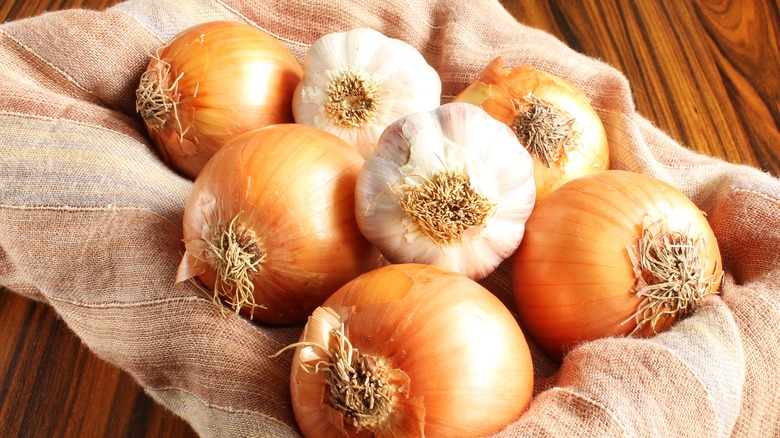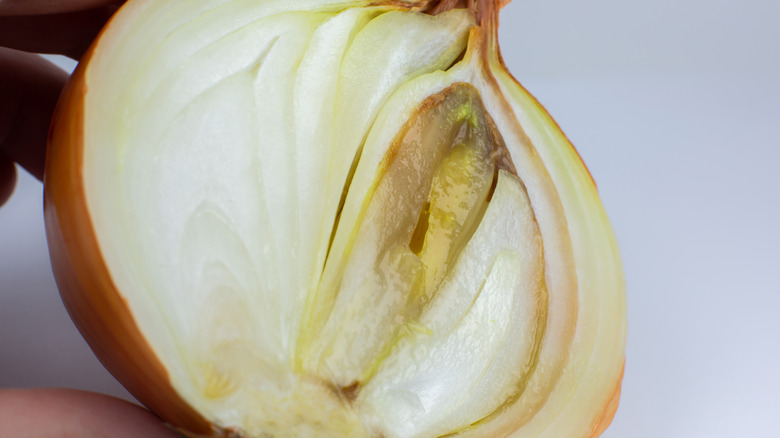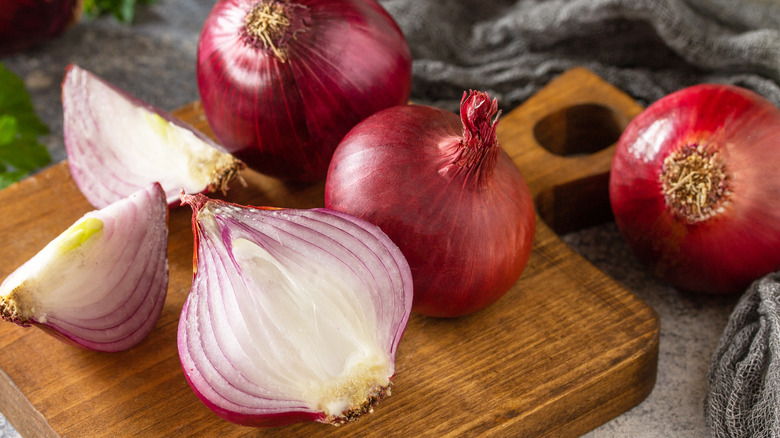How To Actually Tell If Onions Have Gone Bad
Onions make you cry when they're fresh and delicious. But cutting into a bad onion is worth a torrent of tears. It can be difficult to determine if your onion has gone bad even after you cut it, so here is the breakdown on how onions break down.
Onions can be split into two categories: fresh and storage. Fresh onions like spring onions need to be refrigerated and have a much shorter shelf life (via Taste of Home). Storage onions, however, can be stored for one to three months, and in some cases even longer if done well, according to an interview with an Oregon farmer who keeps his onions up to a year in cold storage (via Daily Mail). These types of onions — yellow, white, and red, for example — are kept in storage after harvesting for longer use. Storing them with plenty of ventilation (no plastic bags or closed bins) in a cool, dark, dry place like a pantry or cellar keeps them fresh and useful longer.
Onions absorb moisture
Moisture is an onion's enemy. They are extremely absorbent and sensitive to their environment. The refrigerator is cool, but not necessarily dry. Storing onions in the refrigerator puts them at risk of turning soft from the humidity — even in the crisper (via All Recipes). Other vegetables give off moisture too, which can cause an onion to go bad. One particularly dangerous bedfellow to the onion is the potato. Both need to be stored in cool, dry, dark places, yet the gases emitting from the potatoes and onions interact, causing both to rot, All Recipes continues to explain.
If your onion has absorbed too much moisture, it will give off tell-tale signs so that you know it's gone bad. Look for soft spots on the outside. These can also occur from bruising after being dropped or knocked around. Small spots of discoloration or spots that "give" when you press on them are a sign of rot. If the spot is small and has not gone through all the layers, it can be cut off and the onion still used, according to Mashed.
Onions should be firm
Onions should be firm and hard. If an onion is soft, it has gone bad or begun rotting at its core and should be thrown away (via Does It Go Bad?). If there is discoloration in the skin, it's another sign the onion has rotted and should be discarded. Sprouting, which is a naturally occurring process, can cause an onion to rot, sour, or get bitter inside. If you see a green sprout sticking up out of the onion, there's a good chance it's time to retire it to the compost. Try cutting it open first. If you find that the sprout is only just beginning and the surrounding layers are still firm and give off liquid, you can still use the outer layers. Remove the sprout before cooking, says Kitchn.
Powdery gray or green mold dust is common on the outer paper layers of onion skins and can be brushed off, according to Med Munch. If there is mold inside the onion, throw it away. And if the onion is dry when you cut into it, discard the onion.
The obvious giveaway of a bad onion is its smell. Onions should smell sweet, a sharp, distinct, slightly acidic odor that makes your eyes water. But if the onion is pungent, acrid, or smells rotten — if it's just not pleasant, don't hesitate to dry your tears and start fresh.


